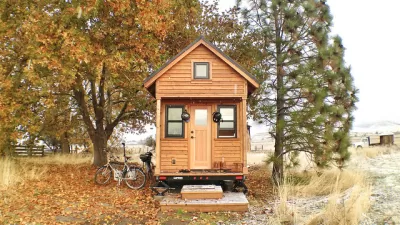Can the tiny house fetish evolve to address real sustainability and affordable housing challenges? Ben Brown says yes.
"I’ve never been much of a fan of the Tiny House movement, which seemed to me to be a solution in search of a problem. Squeezing marginally comfortable living space into something you can haul around with a truck didn’t seem to be much of a design challenge. After all, there’s a whole industry that’s been addressing that demand for generations. You know, RVs."
Brown goes on to discuss his three months living in what many might call a Tiny House. He had no problem functioning happily in its 350-square-feet because "the house was a legal structure on a fixed foundation in a mixed-use, infill neighborhood in easy reach of everything I needed." It's about the neighborhood structure.
Now there are a number of different organizations and ideologies having the same conversation, calling it all different things: weeHouse, pocket neighborhoods, and cottage courts. Brown suggests we broaden the discussion so these parallel paths can converge to a set of best practices.

FULL STORY: Thinking a Little Bigger About the Tiny House Thing

Alabama: Trump Terminates Settlements for Black Communities Harmed By Raw Sewage
Trump deemed the landmark civil rights agreement “illegal DEI and environmental justice policy.”

Planetizen Federal Action Tracker
A weekly monitor of how Trump’s orders and actions are impacting planners and planning in America.

The 120 Year Old Tiny Home Villages That Sheltered San Francisco’s Earthquake Refugees
More than a century ago, San Francisco mobilized to house thousands of residents displaced by the 1906 earthquake. Could their strategy offer a model for the present?

Indy Neighborhood Group Builds Temporary Multi-Use Path
Community members, aided in part by funding from the city, repurposed a vehicle lane to create a protected bike and pedestrian path for the summer season.

Congestion Pricing Drops Holland Tunnel Delays by 65 Percent
New York City’s contentious tolling program has yielded improved traffic and roughly $100 million in revenue for the MTA.

In Both Crashes and Crime, Public Transportation is Far Safer than Driving
Contrary to popular assumptions, public transportation has far lower crash and crime rates than automobile travel. For safer communities, improve and encourage transit travel.
Urban Design for Planners 1: Software Tools
This six-course series explores essential urban design concepts using open source software and equips planners with the tools they need to participate fully in the urban design process.
Planning for Universal Design
Learn the tools for implementing Universal Design in planning regulations.
Clanton & Associates, Inc.
Jessamine County Fiscal Court
Institute for Housing and Urban Development Studies (IHS)
City of Grandview
Harvard GSD Executive Education
Toledo-Lucas County Plan Commissions
Salt Lake City
NYU Wagner Graduate School of Public Service



























